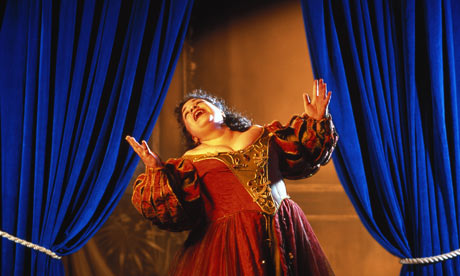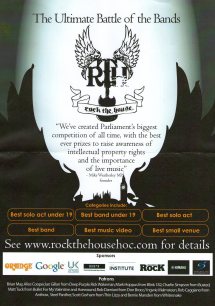
A vocal solo in an opera/cantata/oratorio. Yes it’s that simple.
Opera like singing?
Orchestral accompaniment?
*some exceptions apply but not for the purposes of Intermediate 2! (phew!)
Aria.
Done!


A vocal solo in an opera/cantata/oratorio. Yes it’s that simple.
Opera like singing?
Orchestral accompaniment?
*some exceptions apply but not for the purposes of Intermediate 2! (phew!)
Aria.
Done!
Generally a short vocal composition accompanied usually by an orchestra (and continuo in the Baroque period), which tells a story through the us of recitative, aria and chorus. In the 17th & 18th centuries there were two types. Cantata da Cheisa, religious text for church use, and Cantata da Camera, secular text for Concert performance.
Below is the formula for making a great 12 tone serialist composition.
1. Draw a grid/table 12 columns across and 6 rows down. This is used for planning the notes you will use.
2. Write the following notes into the top row in any order you like. (this is called a tone row)
C, G#, D#, D, F#, C#, A, G, A#, E, F, B
3. In the second row write the same notes backwards. (this is called retrograde)
4. Now write out another four variations of the notes you drew out in step 2 in the remaining four rows.
5. Layout your music score. You will need three instruments, two in treble clef and one in bass clef. The first stave will be the melody, the second will be the counter melody, and the bottom will be the bass line. This means you need to bind the first three staves on your page with a line. Add your treble and bass clefs.
5b. Draw out 24 bars for these three instruments. Add a D.C al Fine at the end of the 24th bar this means the music will return to the beginning and then finish at the “Fine” in bar 12. Add a Fine at the end of the 12th bar. This will give the piece a ternary structure (ABA)
6. It’s time to decide on the rhythms you will use. You’ll need another grid. Yes another one! This time the grid is 4 columns wide and 6 rows down. Each box represents a bar and must add up to 3! However each row must only have 12 notes. Time to use those maths skills!
7. Once you have decided on the rhythms its time to insert the notes. Take the first row of 12 notes from your grid and insert them into the first four bars of the melody using the first row of rhythms. (this will take up the first 4 bars of the melody)
6. Now take the second row of notes and the second row of rhythms and write them into the next four bars of music.
7. Now take the third row of notes and the third row of rhythms and write them into the next four bars of music.
8. Continue until the melody is finished.
9. Now return and repeat the process with the counter melody. This time mix up the rows and rhythms you are using.
10. Repeat this again with the bass line.
11. Write the names of the instruments on the first three staves. Violin, flute, and double bass for example.
12. Add some dynamic markings
13. Add a crotchet = 60 above the start of the melody.
14. Add some decorations, accents, and other marking you like to spice up the music.
15. Decide on a title. Write the title at the top of the page above the music
16. Copy and paste this description into Microsoft Word. Change the sentences to include “I added….”
17. Write the title “Program note” and the name of your composition along with your own name.
18. Give it to the teacher!
Dear Higher Students,
Welcome to a higher place! Please complete the survey below carefully and honestly.
Make sure you complete the form all the way to the bottom and hit “submit” or all that hard work goes to waste.
Thank you!
Mr Whyte
 In a band? Think you’ve got a good song? Are you a soloist bursting with talent and ready to show the world? Looking for a real music experience?
In a band? Think you’ve got a good song? Are you a soloist bursting with talent and ready to show the world? Looking for a real music experience?
Why don’t you rock the house?! The House of Commons that is!
Rock the House is a competition now in it’s 3rd year and was founded to raise awareness of intellectual property rights and live music issues amongst the members of parliament.
The under 19 category is looking for young musicians to come and show their musical talents. There are two categories: best solo act and best band act. My head is running with ideas already. Every person who has taken music has solo pieces ready so all of you can enter.
Our MP Cathy Jamieson will choose the best band and solo act from East Ayrshire who will then go onto the finals!
Prizes include equipment, master classes, and experience seminars from industry professionals.
Last year’s under 19 winners performed at the Ricoh Arena in Coventry and The Tavern Club in Liverpool as well as the Speakers State Rooms. They are heading to Singapore soon to headline the multi-million dollar Arts centre as part of a “Rock Festival”
These opportunities are rare! I know there is a lot of great talent in the music department.
Full details and signup here – http://www.bandapp.com/builder/partner/rockthehouse
Dear S4 students,
Welcome to my new music teaching blog. You can find information on the course requirements as well as useful links and resources. You can access this site from home and look out for important updates. Don’t forget to leave comments and share!
Please answer all the questions below carefully. Remember the only way is aiming for an A! I won’t accept anything less. Filling in this questionnaire will allow me to plan your progress very quickly and easily and make sure you are ready to ace the exam. Are you ready for that? I am.
Aim high. Take part. Let’s go!
Mr Whyte
What do you have to do for composing again? Look no further the SQA provides the answer. Thank you SQA!
OUTCOME
Produce original work which demonstrates development in the creative use of compositional
techniques.
Performance Criteria
a) Initial ideas are selected, explored, developed and refined over a period of time
b) The development of melodic, rhythmic and harmonic possibilities is effective
c) The deployment of performance forces is effective
d) The structure of the piece in the folio is effective
e) Work included in the audio folio is original to the individual candidate and makes musical sense
to the listener
EVIDENCE REQUIREMENTS FOR THIS UNIT
Evidence requirements apply to the Unit as a whole.
Product and supporting documentary evidence is required to demonstrate that the candidate has
achieved the Outcome and Performance Criteria; this will take the form of:
♦ an audio folio of at least 1 minute 30 seconds duration containing one or two pieces of completed
candidate work in composition; these may include elements of improvisation and/or arrangement
♦ a detailed program note and score/performance plan for each piece; this will be produced by
the candidate, will detail the compositional process and will assist understanding of the product
recorded as audio evidence.
Wondering what the requirements are for your final exam? Look no further than the official documentation from the SQA.
“Either
(a) A performance programme on one instrument/voice, solo and/or in a group containing at least
two contrasting pieces of music, and lasting 4 minutes
and
(b) A performance programme on another instrument, solo and/or in a group containing at least two
contrasting pieces of music, and lasting 4 minutes
or
(a) A performance programme on one instrument/voice, solo and/or in a group containing at least
two contrasting pieces of music, and lasting 4 minutes
and
(b) A programme of prepared instrumental and/or vocal accompaniments. The programme should
contain at least 2 contrasting accompaniments and last 6 minutes
and
(c) A performance of accompaniments played at sight and lasting 2 minutes”
Students of higher and intermediate 2!
Another great website to get familiar with your listening concepts. Definitions, examples, and a nice easy to use design.
http://www.musiclisteningrevision.co.uk/intermediate1/intermediate1index.htm